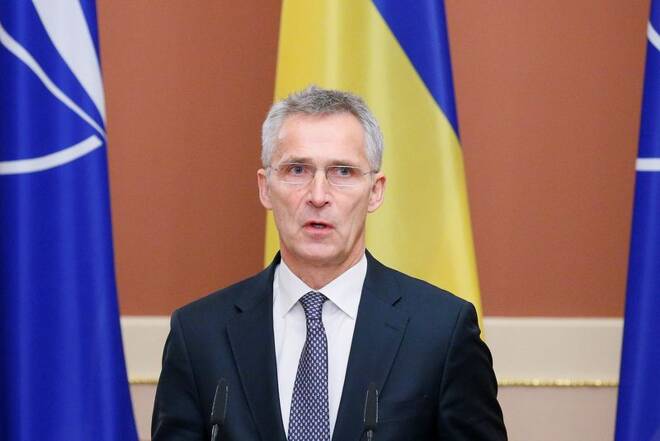Advertisement
Advertisement
NATO warns Russia over Ukraine military build-up
By:
By Sabine Siebold and Robin Emmott BRUSSELS (Reuters) - NATO Secretary-General Jens Stoltenberg warned Russia on Monday that the western military alliance was standing by Ukraine amid a large and unusual concentration of Russian troops on Ukraine's borders.
By Sabine Siebold and Robin Emmott
BRUSSELS (Reuters) – NATO Secretary-General Jens Stoltenberg warned Russia on Monday that the western military alliance was standing by Ukraine amid a large and unusual concentration of Russian troops on Ukraine’s borders.
Stressing that the important thing now was to prevent situations from spiralling out of control, Stoltenberg urged Russia to be transparent about military activities, to reduce tensions and prevent an escalation.
“We have to be clear-eyed, we need to be realistic about the challenges we face. And what we see is a significant, large Russian military build-up,” Stoltenberg told a news conference with Ukraine’s Foreign Minister Dmytro Kuleba in Brussels.
He said he did not want to speculate about Russia’s intentions but added: “We see an unusual concentration of troops, and we know that Russia has been willing to use these types of military capabilities before to conduct aggressive actions against Ukraine.”
The Russian troop movements have over the past days spurred fears of a possible attack. Moscow has dismissed such suggestions as inflammatory and complained about increasing activity in the region by the NATO transatlantic alliance.
Russia annexed Crimea from Ukraine in 2014 and says the waters around it belong to Moscow now, despite most countries continuing to recognise the peninsula as Ukrainian.
Russian-backed separatists took control of Ukraine’s eastern Donbass region that same year and soldiers on both sides continue to be regularly killed in the conflict there.
The troop border build-up – which Ukraine last week estimated at 100,000 – was dangerous, said Stoltenberg, because it reduced the amount of warning time, should Russia decide to “conduct a military aggressive action against Ukraine.”
“This is partly forces close to the border between Russia and Ukraine, but it is also partly troops and capabilities which are inside Ukraine, meaning they are in Crimea, which is illegally annexed, and also we see the militants, the separatists in Donbass, which is also part of Ukraine, supported and helped by Russia,” he said.
A NATO source, asked to describe how Russia is going about deploying its military equipment towards Ukraine, said: “large equipment such as tanks, self-propelled artillery and infantry fighting vehicles is moved at night to avoid tell-tale pictures showing up on social media as they did during the Russian military build-up in spring.”
“It can go either way,” Lithuania’s foreign minister Gabrielius Landsbergis told reporters, also on Monday, on the margins of a meeting with his European Union counterparts.
The West cannot exclude a Russian attack on Ukraine while international attention is focused on the Belarus migration crisis, or that Russia establishes a permanent military presence in Belarus, he said.
“I would not exclude that as a possibility,” he said.
(Reporting by Sabine Siebold and Robin Emmott; Writing by Ingrid Melander; Editing by Alex Richardson, William Maclean)
About the Author
Reuterscontributor
Reuters, the news and media division of Thomson Reuters, is the world’s largest international multimedia news provider reaching more than one billion people every day. Reuters provides trusted business, financial, national, and international news to professionals via Thomson Reuters desktops, the world's media organizations, and directly to consumers at Reuters.com and via Reuters TV. Learn more about Thomson Reuters products:
Advertisement
